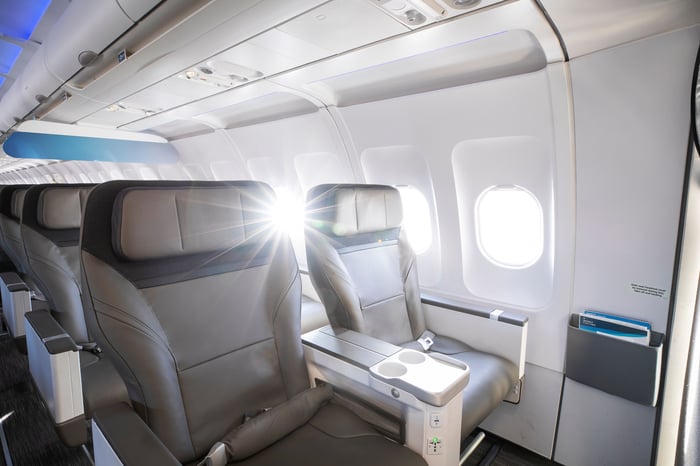The COVID-19 pandemic has forced U.S. airlines to make tough decisions about their route networks. Many carriers are shoring up the strongest parts of their route networks and boosting capacity to popular leisure markets: particularly outdoor-focused destinations. Meanwhile, they are culling long-term underperforming routes that had stuck around before the pandemic for one reason or another.
Alaska Air (ALK 4.71%) just made a big decision in this vein. The West Coast airline recently confirmed that it will end service between New York's John F. Kennedy International Airport (JFK) and Los Angeles International Airport (LAX) this fall, exiting what was the busiest airline route in the U.S. before the pandemic.
A route that never really worked for Alaska
Alaska Airlines inherited the JFK-LAX route from merger partner Virgin America several years ago. When Virgin America launched transcontinental service from JFK to San Francisco (SFO) and Los Angeles in 2007, it revolutionized the market with its swanky first-class recliner seats and tech-influenced inflight experience. However, other airlines subsequently upped their games in these key transcontinental markets -- particularly by installing new first-class and business-class seats that convert to fully flat beds -- eroding Virgin America's advantage.
Rather than matching competitors' upgrades, Alaska Airlines decided to cut costs and standardize its fleet by removing Virgin America's posh first-class seats in favor of standard domestic first-class seats. Not surprisingly, that further reduced the appeal of Alaska's first-class product on the JFK-LAX and JFK-SFO transcontinental routes.

The first-class seats on Alaska Airlines planes are very ordinary. Image source: Alaska Airlines.
In the JFK-SFO market, Alaska Airlines can at least rely on a large base of loyal customers, as it is the No. 2 airline in San Francisco. By contrast, the Los Angeles market is ultra-competitive and Alaska is a distant No. 5 in market share. Moreover, coach fares between JFK and LAX tend to be quite low. As a result, none of Alaska's strategy shifts were able to make its JFK-LAX route successful.
Calling it quits
Just four years ago, Virgin America was operating six daily flights between JFK and LAX. However, Alaska began trimming service on that route in 2018 in order to repurpose some of its JFK slots for nonstop flights in markets with less competition -- and where it might have more of a competitive advantage.
Alaska has continued to reduce its flight frequencies on the JFK-LAX route since then. The route will disappear for good as of Oct. 6.
Once again, the carrier plans to redeploy its JFK slots to markets where it has more of a competitive advantage. It is increasing service between Seattle and JFK to four daily roundtrips, doubling service between Portland and JFK to two daily roundtrips, and growing its San Diego-JFK route -- which launched just a few months ago -- to two daily roundtrips. Notably, Alaska is the dominant airline in Seattle and Portland, and it is the second-largest carrier in San Diego (albeit a distant No. 2).

Image source: Alaska Airlines.
What it means for Alaska and its rivals
Alaska Airlines has experienced a solid demand recovery year to date. Its core Pacific Northwest markets have performed particularly well. This makes it an opportune time to dump underperforming routes in markets that are less significant strategically. Los Angeles certainly fits the bill, given the intensity of competition there and Alaska's relatively low market share.
It may take a little while for the Seattle, Portland, and San Diego routes to absorb increased capacity, given that domestic travel demand hasn't fully recovered yet. But by next summer, those routes should be solidly profitable -- unlike the underperforming LAX-JFK route -- driving incremental earnings for Alaska Air.
Alaska's decision to exit this key market will also be a boon to other airlines that fly this route. JetBlue Airways could be a particularly big beneficiary over the next couple of years, as it offers frequent service between JFK and LAX with low fares and plenty of coach seats on each flight.
As many airlines make similar moves to retrench in non-strategic markets and double down in their core markets, it seems increasingly likely that the U.S. airline industry will be even more profitable than it was before the pandemic within a few years.



